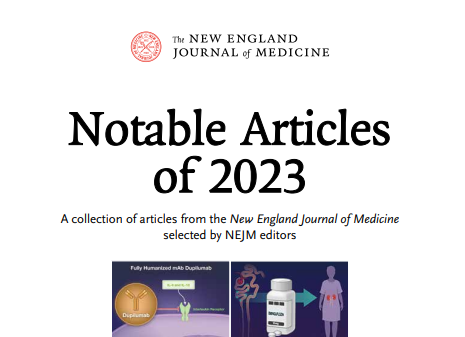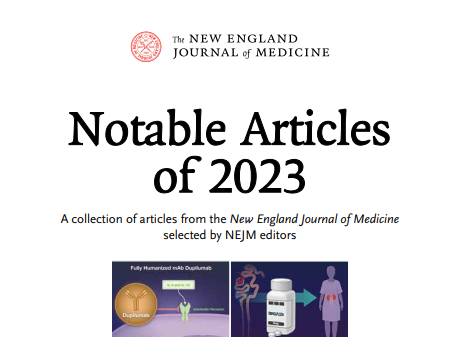Eric J. Rubin, M.D., Ph.D.
Editor-in-Chief, New England Journal of Medicine
December 2023
Dear Reader, In December, as our attentions turn to the new year ahead, I always find it interesting to reflect on the studies we’ve published in the past year and evaluate their contribution to the ever-evolving practice of medicine.
While the last couple of years have been dominated by Covid-19 news, this year our Notable Articles collection focuses on new approaches to diverse diseases.
I’ve highlighted several new interventions, including
- advances in oncology, such as “universal” CAR-T cells that have undergone gene editing to allow them to be used off-the-shelf without having to be derived uniquely for each host, an approach that could bring therapy to a much broader range of patients.
- New antitumor targets, such as KRAS containing the G12C mutation, are now accessible with inhibitors, and we are seeing the first evidence that this class of agents is active in a variety of tumors in combination with other antitumor strategies.
- New targets are also emerging in kidney diseases, including aldosterone synthase, which can be inhibited to effectively treat hypertension, and APOL1, whose variants are associated with proteinuria.
- Moreover, existing drugs, such as the sodium–glucose transporter 2 (SGLT2) inhibitor empagliflozin, can reduce disease progression and cardiovascular disease in patients with chronic kidney disease.
- And we published more in a series of studies examining the effects of antibodies that bind to the Ab protein and clear amyloid. Some, such as a study of lecanemab, have shown positive, though small, effects in early Alzheimer’s disease.
- We have also seen new applications for other agents. Dupilumab, an antibody that blocks type 2 inflammation, reduces the number of exacerbations and improves the quality of life of patients with COPD who have high eosinophil counts. GLP-1 agonists, which were developed to treat diabetes, also reduce obesity and improve heart failure in obese individuals.
- And we have seen the first drug, retatrutide, that not only acts at GLP-1 but also at two other receptors, glucose-dependent insulinotropic polypeptide (GIP) and the glucagon receptor. Treatment with retatrutide results in dramatic weight loss in obese and overweight subjects.
- Ketamine, a dissociative anesthetic, proved to be noninferior to electroconvulsive therapy in treatment-resistant depression. My list this year contains two important trials in infectious disease.
- Using a new treatment strategy, investigators found that the majority of patients with antibiotic-sensitive tuberculosis could be cured in as little as two months, a substantial shortening from the standard six month regimen.
- This was also the year that the first successful vaccine against respiratory syncytial virus was shown to be active, both in older adults (in studies not included in the list) and in pregnancy.
When pregnant women are vaccinated, their children are protected by maternal antibody.
On behalf of the editorial team, we hope you enjoy reading this collection of studies that we believe stand out among the year’s most notable and impactful in clinical medicine.
As we look forward to the new year, we at the Journal remain committed to publishing only the most valuable, peer-reviewed studies — studies you can trust to inform and guide the care you provide to your patients.
Sincerely,
Eric J. Rubin, M.D., Ph.D. Editor-in-Chief, New England Journal of Medicine













